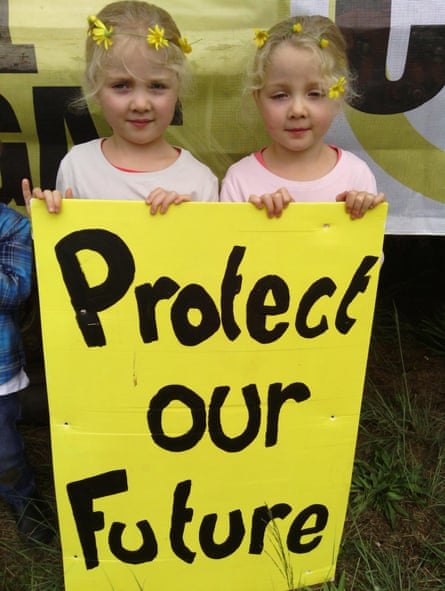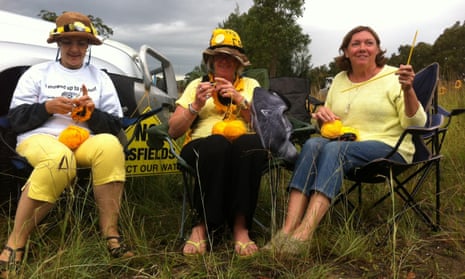When the Knitting Nannas Against Gas attend an environmental protest, they don’t just pack banners and hand-painted posters – they make sure they have a pair of knitting needles and a few balls of yarn too.
The all-female, all-knitting movement began in Lismore, a community in north-western New South Wales, as a form of non-violent protest against the coal seam gas industry.
As gas proposals and exploratory drilling spread to other parts of NSW, the Knitting Nannas movement followed, with 20 local chapters now across the state.
On Sunday the needles were out in force, joining hundreds of other (knitting and non-knitting) anti-CSG protesters who spread themselves over 2,000km of highway, opposing the coal seam gas industry in what has been dubbed “Australia’s longest ever highway demonstration”.
Anti-CSG group Northwest Alliance reported 500 people set up more than 250 protest stations along the Pacific and Newell highways and across other major roads straddling NSW and Queensland in an attempt to attract the attention of families heading home on the final weekend of the school holidays.
Coal seam gas was a key state election issue for north-western NSW, with residents concerned about the potential burden on local water supplies, intrusive noise and light pollution, and citing ongoing issues of water pollution management in the industry.
The Baird government has continued to show support for further gas projects, insisting it is necessary to keep energy prices down. A recent report by the Australian Energy Market Operator said there was no shortage in the gas supply.
Projects in NSW by AGL, Santos, Dart Energy and also over the border by Queensland Gas Company have all faced varying degrees of community opposition.
No single organising committee directed Sunday’s protest, which was conceived five months ago during discussions by a handful of residents in the NSW town of Coonabarabran. Word spread, both offline and on, and enthusiasm for the demonstration snowballed, so that on Sunday it extended almost six times its original 500km distance. In some sections, protests were stationed as close as every 2km.
Dominique Jacobs, a 50-year-old “Nanna” from Gloucester in the Hunter region of NSW, on Sunday stationed herself on a busy intersection of the Pacific Highway called 12 Mile Creek. Dressed in the anti-CSG movement colours of black and yellow with a knitted chain of sunflowers around her neck, she said she was there to “highlight our displeasure to the general public, the government and AGL”.
Gloucester is where AGL has based a project it claims has the potential to supply more than 15% of the state’s gas needs by 2018. The pilot program was suspended in January after BTEX chemicals were detected in monitoring samples, with investigations by the Environmental Protection Authority pending.

Like many Knitting Nannas, Jacobs has had no prior experience of environmental activism. Concern for how the project may affect her seven children inspired her to join the movement. “If it goes ahead we won’t live here. We still have young children who go to school in town, which is too close to all that [gas] flaring,” she said.
For towns like Gloucester, the internet has helped them connect with other communities opposed to coal seam gas, said Jacobs. “Every time coal seam gas goes somewhere new, it’s a learning curve for that community,” she said .
The drive to Gloucester via Bucketts Way takes you through the pristine countryside so many of the protesters are determined to protect – lush, green farmland and streams with water so clear you can see straight through to the rock bed.
Linda Gill, 60, is a Knitting Nanna from the Great Lakes region and one of 75,000 people living in a water catchment that could be affected by the Gloucester project. On Sunday she held a sign reading “Toot if you’re against CSG”. She estimated one in six drivers who passed her Pacific Highway station at Wootton gave a supportive honk.
The grandmother of three says the Knitting Nannas movement began as a way to “knit, chat and plot how to stop coal seam gas”.
“People feel quite comfortable chatting to us. Everyone loves their nanna. Nannas aren’t going to lie to you. We want you to know what’s right and wrong,” said Gill.
And though distance separates her and other chapters of knit and purl protest makers, she feels a sense of camaraderie nonetheless. “I’m connected to everyone in the state who is against CSG, connected by the highways,” said Gill. “We’re knitting a nanna-lution!”


Comments (…)
Sign in or create your Guardian account to join the discussion